May 19, 2025 | 14:14 GMT +7
May 19, 2025 | 14:14 GMT +7
Hotline: 0913.378.918
May 19, 2025 | 14:14 GMT +7
Hotline: 0913.378.918
On July 2-3, 2024, in Gia Lai, the Vietnam Academy of Agricultural Sciences (VAAS) collaborated with the Asia-Pacific Food and Fertilizer Technology Center (FFTC-ASPAC) to organize an international workshop on “Strengthening Quality Management for the Passion Fruit Value Chain in the Asia-Pacific Region.” Many significant papers on the development of passion fruit in the region were presented, followed by Q&A sessions. Vietnam Agriculture News has translated, compiled, and respectfully introduced these to our readers.
Below is a presentation by Dr. Nguyen Thi Bich Ngoc, Deputy Director of the Plant Protection Institute (Vietnam Academy of Agricultural Sciences).
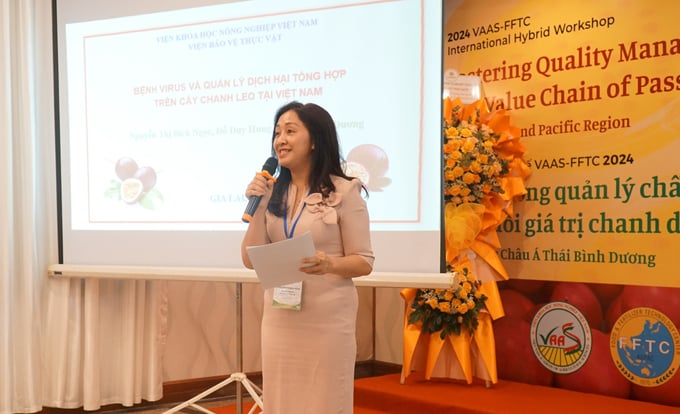
Dr. Nguyen Thi Bich Ngoc presented at the workshop "Strengthening quality management for passion fruit value chain in the Asia - Pacific region" on July 2 in Gia Lai. Photo: Tuan Anh.
Passion fruit (Passiflora edulis), belonging to the passion flower family, is a nutritious fruit rich in antioxidants, minerals, vitamins, and fiber. Passion fruit was first introduced to Vietnam during the French colonial period. Before 2015, passion fruit cultivation was primarily concentrated in the Lam Dong and Dak Nong provinces. Since 2015, the consumption market, particularly the processing and export sectors, has expanded significantly. The average annual growth rate in cultivation area from 2015 to 2022 reached 31.1% (equivalent to 1,000 hectares per year).
Currently, the passion fruit cultivation area has expanded to 9,500 hectares, yielding 188,900 tons, making it one of the 18 types of fruit in Vietnam with an annual output exceeding 100,000 tons (according to 2023 data from the Department of Crop Production).
The Central Highlands is the primary passion fruit growing region in the country, with about 8,200 hectares under cultivation in 2022 (over 86% of the total area). Gia Lai province boasts the largest passion fruit growing area, with more than 4,263 hectares producing over 134,000 tons in 2022. This province also attracts and concentrates businesses involved in seed production, processing, and consumption of passion fruit, making it the largest hub in the country. Following Gia Lai are the Dak Lak, Dak Nong, and Lam Dong provinces.
The Northern midlands and mountains form the second largest passion fruit growing area, with more than 1,000 hectares (over 11%), primarily concentrated in Son La province (Department of Crop Production, 2023). The predominant variety today is the purple fruit variety Dai Nong 1 (LPH04), which accounts for more than 95% of the cultivated area. Recently, two new varieties bred by Nafoods Group Company (Nafoods 1 and Que Phong 1) have been introduced, enhancing the variety structure in production.
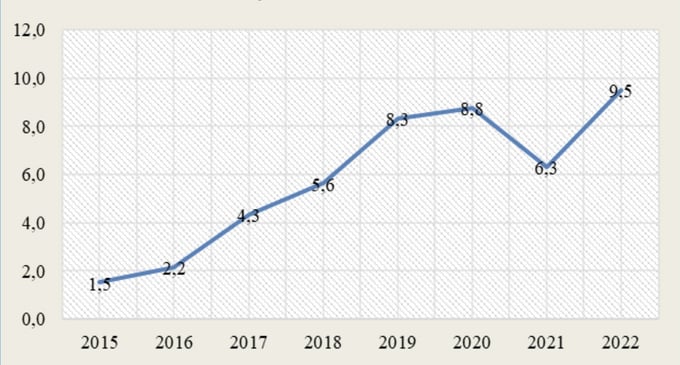
In 2022, passion fruit in Vietnam will have an area of up to 9,500 hectares, but currently the area tends to decrease due to disease pressure.
Vietnam has become one of the largest producers and exporters of passion fruit in the world, ranking among the top 10 supplying countries, alongside Brazil, Colombia, Ecuador, and Peru. Since July 2022, Vietnamese passion fruit has been officially exported to the Chinese market, opening significant opportunities for production expansion. In the same year, the Ministry of Agriculture and Rural Development issued Directive No. 8084/CT-BNN-TT on the sustainable development of passion fruit production.
Thus, the passion fruit industry not only plays a crucial role in Vietnam's agriculture but also opens many economic development opportunities through exports, strengthening Vietnam's position in the international market. However, to maintain and develop sustainably, integrated plant health management and effective responses to pests on passion fruit need greater focus and investment.
Several localities, including Gia Lai, Nghe An, and Dak Lak provinces, have focused on the selection and recognition of parent trees and parent passion fruit gardens. In Gia Lai, as of mid-September 2022, the Department of Agriculture and Rural Development has recognized 100 parent trees and 14 parent passion fruit gardens. The province has also established a three-level passion fruit seedling production system in advanced, disease-free greenhouses, producing millions of seedlings per year (implemented by companies such as Nafoods and Thong Do).
However, pests and diseases remain the primary challenges affecting sustainable passion fruit production in Vietnam.
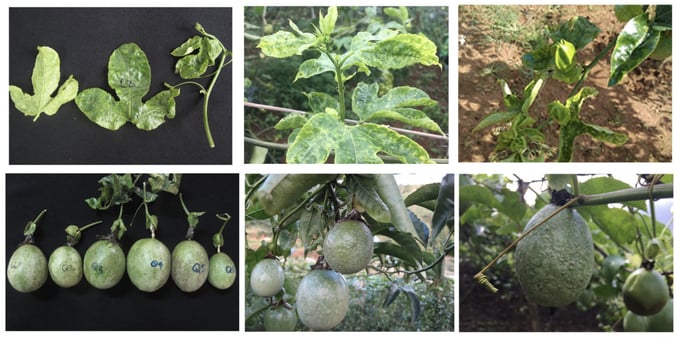
Viral diseases are the main cause affecting sustainable passion fruit production.
Currently, six species of viruses harmful to passion fruit plants have been identified:
East Asian Passiflora virus - EAPV; Passiflora mottle virus - PaMoV; Telosma mosaic virus – TelMV; Papaya leaf curl Guangdong virus - PaLCuGdV; Euphorbia leaf curl virus - EuLCV; Cucumber mosaic virus - CMV.
Among these, three species of potyviruses – East Asian Passiflora Virus (EAPV), Passiflora Mottle Virus (PaMoV), and Telosma Mosaic Virus (TelMV) – are responsible for causing fruit hardening. The symptoms vary depending on the virus species and the possibility of infection with one or more viruses on the same plant sample.
Investigation results from 2018, examining 132 samples of passion fruit with viral diseases in the Central Highlands (Gia Lai, Dak Nong) and Son La, indicated that fruit hardening disease in Vietnam is mainly caused by PaMoV (58%), followed by EAPV (26%), a PaMoV/EAPV mixture (14%), and very rarely TelMV (2%).
Brown spot disease (Alternaria alternate; Alternaria passiflorae): This disease damages leaves and fruits, forming round reddish-brown spots. Severe infection leads to leaf tearing, rotting, and fruit drop.
Stem and fruit rot (Phytophthora nicotianae): This disease affects all parts of the plant, causing fruit rot, fruit drop, leaf rot, stem rot, and root rot. Severe cases can result in plant death.
Anthracnose (Colletotrichum gloeosporioides): This disease damages leaves, stems, branches, and fruits. Lesions appear light to dark brown, slightly round, or irregular in shape. The disease causes flowers, leaves, and fruits to fall off, and severe cases can cause the top of the tree to die.
Root rot, swollen stem (asexual stage Fusarium solani, sexual stage Nectria haematococca): This disease causes the base of the stem to swell and crack vertically. Severe infection results in the stem turning black and rotting completely, causing the passion fruit plant to wilt and die.
Aphids (Aphis gossypii, Myzus persicae): Aphids cause leaves to curl and deform, leading to poor plant growth, yellowing, and wilting leaves, as well as small fruit susceptible to gray mold. Aphids are vectors for several passion fruit viruses, including EAPV, TelMV, PaMoV, and CMV.
Whitefly (Bemisia tabaci ): This pest damages young shoots and leaves, causing them to yellow. Whiteflies are vectors for transmitting viruses such as PaLCuGdV and EuLCV in passion fruit.
Thrips (Thysanoptera sp.): Thrips cause curling and deformation of leaves, flowers, and fruits.
Stink bugs: Various species, including the spiny stink bug (Cletus punctiger Dallas), green stink bug (Nezara viridula L.), and large-legged stink bug (Leptoglossus australis Fabricius), suck on leaves, flowers, young shoots, and fruits, causing spots on the fruit. Severe damage can lead to fruit drop.
Small spiders: There are two main types of pests on passion fruit: red spider (Tetranychus sp.) and white spider (Polyphagotarsonemus latus B.). They damage leaves and fruit surfaces by sucking, leading to yellow and curled leaves. High densities can cause leaves to dry and fall off, fruit peels to lose color, and fruits to become deformed and slow to develop.
Fruit flies (Bactrocera dorsalis Hendel and Bactrocera correcta Bezzi). These flies cause young fruit to shrivel and fall prematurely. On mature fruit, the damaged area is slightly concave with a hard, gray-white shell and a black dot in the center of the damage. Damage from fruit flies reduces the commercial value of the fruit.
The management and control of pests on passion fruit are crucial to ensuring sustainable and efficient production. Research and development of disease-free and disease-resistant varieties, combined with advanced farming practices, will help minimize damage caused by viral diseases, contributing to improving the quality and yield of passion fruit in Vietnam.
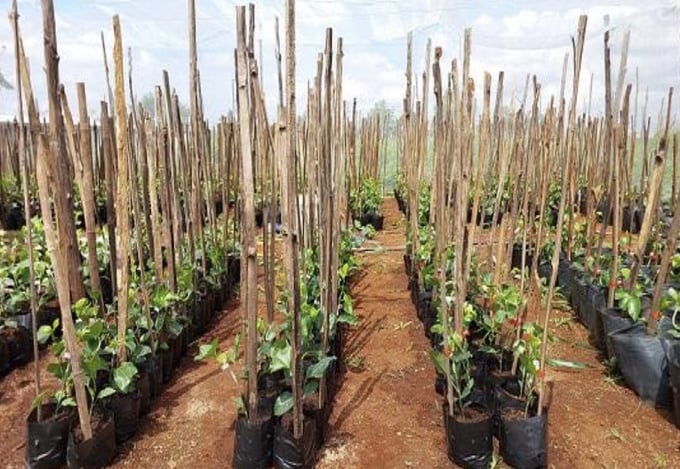
Train seedlings in a quarantine greenhouse before planting new ones (20 - 25 days).
Use seedlings from reputable domestic and foreign seed production facilities with verified quality. Seedlings must be certified as virus-free and free from soil-borne fungi such as Fusarium and Phytophthora.
Soil preparation
- Clean up weeds, plant residues, and remove virus host plants and disease vectors in the area where passion fruit is planned to be grown.
- Treat termites, nematodes and other underground pests before planting.
- Disinfect the soil with 0.5 kg of lime powder per hole at least 15-20 days before planting.
Density : Depending on land conditions, farming practices, and climate conditions of each region, choose the appropriate planting density, typically from 800-1,000 trees/ha (4m x 3m, 3m x 3m).
Plant above ground, on well-drained raised beds to limit the spread of soil-borne diseases.
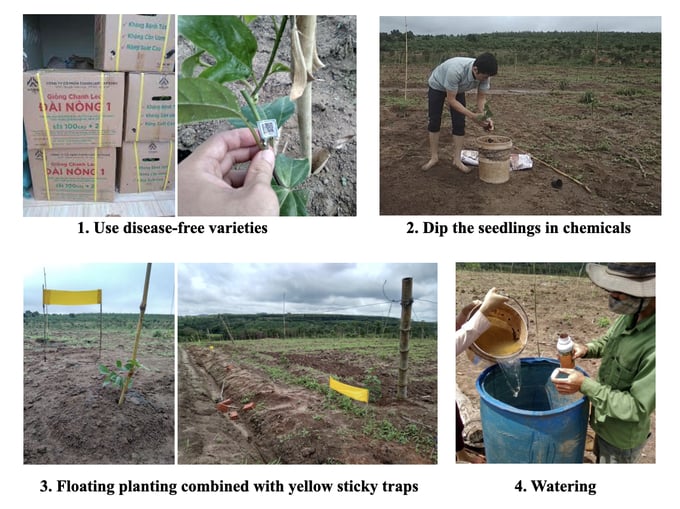
Requires the use of disease-free seeds, planting on high mounds or on well-drained beds, and the use of biological products.
Field sanitation
- Regularly inspect the field to detect early signs of pest and disease infestations. Collect and thoroughly destroy plant parts infected with pests and diseases. Remove and replace plants showing signs of viral diseases such as curling, yellow leaves, and tops.
- Annually disinfect the garden with 500 kg/ha of lime powder (applied in two doses). Sprinkle the entire garden or apply to drainage ditches to disinfect disease sources and increase soil pH.
Pruning techniques
- After harvesting, cut off all the branches on the trellis that have produced fruit. Leave the trunk and branches from the ground to the trellis. When new shoots sprout to 2-3 cm, spray pesticides to protect the young shoots.
- Pruning tools must be disinfected with 1% bleach or alcohol before moving on to pruning another tree. All pruned branches, leaves, and fruits must be removed from the garden. Do not leave or cover branches at the base of the tree.
Net covering technique to protect plants from virus transmission
Covering trees with protective nets in the fields
- Complete Net Coverage: Set up the net cage at each planting location before sowing.
- Use plastic mesh with a size ranging from 90-120 cells/cm². The mesh cage should be 2.5m long x 0.7m wide, equipped with a door for easy opening and closing as needed.
- Use a 3m high bamboo pole in the middle of the planting hole for the plant to climb. Position four 2.5m high bamboo poles, 2-3 cm thick, at the four corners, spaced 50 cm apart to stretch the net cage. Cover the net cage outside the bamboo poles, pull the edge of the net close to the ground to stretch it, fill the soil to cover the bottom of the net, and seal the doors. Secure the top of the net cage close to the surface of the passion fruit trellis. Remove the net cage once the top of the plant reaches the top of the net cage.
Cover the seedlings with protective net before planting
- Seedlings must be planted in large pots with a minimum size of 20 cm x 30 cm. The area covered with the net should be airy, cool, not shaded, and free of weeds and plants that are hosts to aphids and whiteflies. Before placing the plants in, spray pesticides to prevent aphids and whiteflies in and around the net-covered area.
- Use a plastic net with a mesh size of 90-120 cells/cm², with doors for easy access. Depending on the number of trees, design a suitable cover net with a minimum height of over 2m.
- Protect seedlings for 30-45 days before planting or until the trees reach a height of 1.2-1.4m, at which point they must be planted in the field.
Other techniques such as irrigation, drainage, fertilization, and weeding should be applied according to the technical guidelines for planting and caring for passion fruit trees in each locality. trees in each locality.
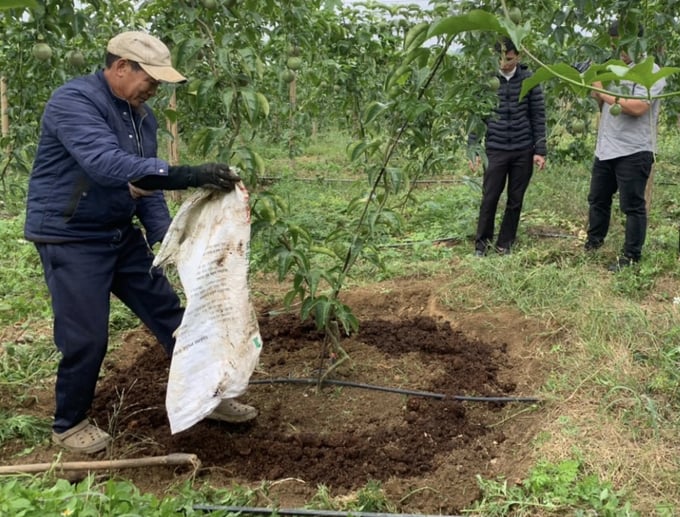
Apply organic fertilizers and biological products after each harvest.
Utilize products containing antagonistic microorganisms such as Trichoderma fungi, Streptomyces actinomycetes, Bacillus bacteria, and nematode-killing herbs with active ingredients like saponins and alkaloids. Additionally, employ Metarhizium insect parasitic fungi and other beneficial microorganisms to prevent harmful fungi and nematodes in the soil.
Biological products can be applied in combination with fertilizers or sprinkled in the root zone and then covered with soil. During the dry season, these products can be dissolved in water for irrigation.
Before and after the rainy season, use Trichoderma antagonistic fungus at a concentration of 0.5% and water the roots 3-4 times per crop, with each application 10-15 days apart.
Use chemicals according to the four correct principles and only those registered in the List of Plant Protection Drugs permitted in Vietnam. Follow the manufacturer's recommendations for concentration and dosage.
For fungal diseases (brown spot disease, stem rot, fruit rot, root rot - stem swelling, anthracnose)
When the disease first appears, use chemicals containing active ingredients such as Tebuconazole, Mancozeb, Propineb, Metalaxyl, Dimethomorph, Difenoconazole, Azoxystrobin, Chlorothalonil, Fosetyl Aluminum, Copper oxychloride, or Hexaconazole for prevention. Spray when the plants have new shoots or at the beginning of the rainy season. If the disease persists and causes significant damage, repeat spraying 7-10 days after the initial application. Rotate the use of different chemicals to prevent resistance.
Treat newly infected roots and surrounding plants with chemicals containing active ingredients such as Phosphonate, Fosetyl-aluminum, Mancozeb, or Metalaxyl. Apply treatments once or twice at the beginning and end of the rainy season by watering, rinsing the roots, or brushing the chemicals onto the diseased areas.
For viral diseases and vector insects (aphids, whiteflies, thrips)
Hang yellow traps to predict the early appearance of virus vectors and regularly check the garden for timely prevention.
Spray to prevent vectors such as aphids and whiteflies using chemicals with active ingredients such as Spirotetramat, Abamectin, Emamectin benzoate, or Matrine. Begin spraying from when the tree is newly planted until it is established on the trellis.
When the tree has new shoots or after pruning, use chemical pesticides to spray for sucking insects.
For harmful spiders
Use drugs alternately containing active ingredients such as Abamectin, Abamectin + Petroleum oil 39.7%, Propargite, or mineral oil. Spray evenly on the surface of leaves and other parts of the plant. If spider mites persist after 3-5 days, apply a second treatment.
For fruit flies
Use yellow sticky traps or lure traps with the active ingredient Methyl Eugenol outside the garden to predict the appearance of flies. When flies are detected in the traps, spray protein bait (ENTO - PROTEIN 150DD) as per the manufacturer's instructions. Spray the protein bait over a large area simultaneously to increase the effectiveness of fly control.
The effectiveness of the model applying synthetic measures:
The synchronous implementation of these measures will significantly improve the productivity and quality of passion fruit, ensuring sustainable development for the industry in Vietnam. Passion fruit growers need to enhance their capacity to manage various pests and diseases while integrating soil, irrigation water, and fertilizer management solutions.
Translated by Quynh Chi

(VAN) 14 out of 35 domesticated elephants in Dak Lak province have had their living conditions improved, with 11 of them currently participating in the non-riding elephant tourism model.

(VAN) Muong Nhe Nature Reserve hopes that being upgraded to a national park will lay the foundation for forest protection efforts to be carried out in a systematic, modern, and sustainable manner.
/2025/05/16/3923-2-171845_52.jpg)
(VAN) Lower costs, higher yields, and improved soil quality are outstanding benefits that soybeans bring when integrated into the crop rotation system.
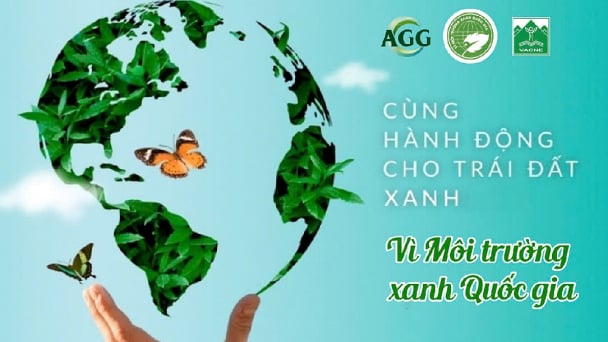
(VAN) The 'For a Green National Environment' programme aims to promote a green lifestyle, support businesses in implementing ESG practices, and turn Net Zero commitments into concrete actions.

(VAN) Cold-barn systems efficiently manage environmental and temperature conditions, which aids in the prevention of respiratory diseases in pigs and protects them from the vectors that transmit African swine fevers.
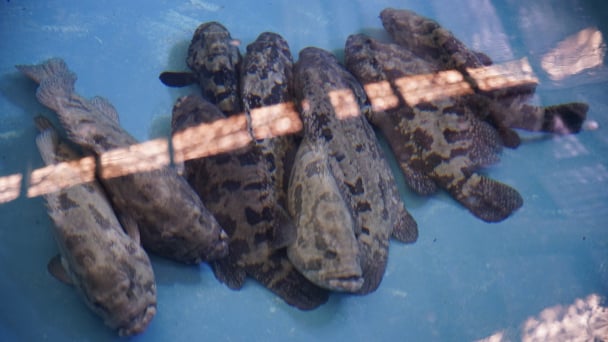
(VAN) To tackle challenges, the project 'Addressing key technical bottlenecks in the grouper supply chain in Vietnam' has been underway since 2024.
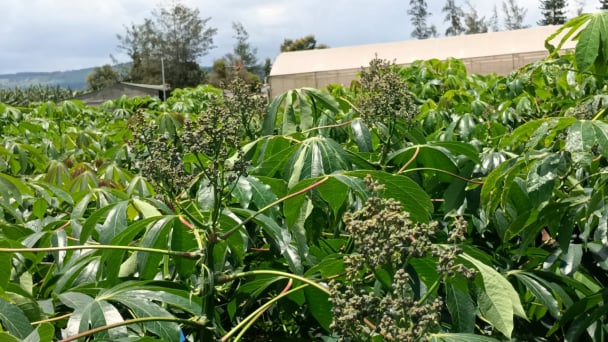
(VAN) The project 'Disease-Resilient and Sustainable Cassava Production Systems in the Mekong Region', funded by the Australian Center for International Agricultural Research (ACIAR), is being implemented from 2024 to 2028.